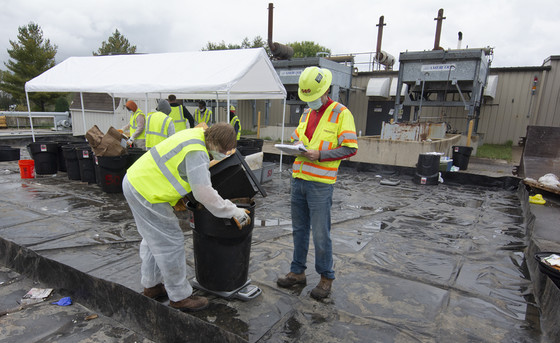Environment
The Wisconsin DNR searches for waste trends and solutions in landfills

Turning trash into invaluable information, the Wisconsin DNR launched a waste characterization study at Wisconsin landfills.
This past September, SCS Engineers began collecting and sorting samples of municipal solid waste at landfills across the state as part of a study aimed at better understanding what Wisconsinites are throwing in the trash.
The results of the study will provide a powerful planning tool for waste reduction and minimization efforts across the state, and when compared to prior studies conducted in 2003 and 2009, will help officials identify trends in waste and recycling. The study will be released publically to benefit communities and possibly businesses that are considering investing in new equipment or building a new facility that can divert waste into a profit.
“Millions of pounds of materials are diverted through recycling, e-cycling, or composting every year, which keeps hazardous materials out of the environment, saves valuable landfill space, and supports Wisconsin’s economy,” said Kate Strom Hiorns, DNR recycling, and solid waste section chief. “But more can be done. This study will help determine the communication, infrastructure, and resources still needed.”
Crews will visit 12 landfills across the state to sort 400 municipal solid waste samples and visually characterize 640 construction and demolition waste loads. Crews are trained to identify 85 material types, representing eight waste categories including plastics, organics, and hazardous materials. The region, hauler type, and the source of the waste will also be recorded.
“The DNR is looking for opportunities to minimize and divert waste statewide, but also at the source or regional level,” said Casey Lamensky, DNR solid waste coordinator. “The DNR will continue to work with local governments, businesses, and organizations to ensure they have the resources they need to divert materials from the landfill.”
Waste characterization data from 2003 and 2009 provided crucial information for waste management decisions still affecting residents today. Dane County used the 2009 study, which identified construction and demolition materials as one of the top contributing material groups, to properly size a construction and demolition recycling facility at the Rodefeld Landfill.
“We hope the 2020 data will be similarly used,” Lamensky said. “Dane County is a great example of why this information is important.”
A noticeable trend now is new food packaging that not recyclable in the current system as containers shift from steel cans to multi-layer lined packages. She also noted that food waste increased between the 2003 and 2009 studies.
“This will help us get information on what we can do to help decrease the number of organics going to the landfill similar to what we did to help decrease the demolition materials,” Lamensky said. “Organics are incredibly impactful to the environment.”
In the 2009 study, 17 percent of household waste was food waste. As Lamensky explained, the food goes through production, transportation, packing, transportation, storage, and then transportation again, utilizing several resources to end up in a landfill. Additionally, when it is put in the landfill, organic waste is compacted down to the point where oxygen is removed.
“That means organic materials degrade anaerobically, or with different microbes that do not need oxygen,” she said. “The release of that is methane, which is a greenhouse gas that is 26 to 28 times more powerful than CO2. If you look at the world’s food waste just as a greenhouse gas generator, it would actually be the third-largest after the U.S. and China.”
There are some contained systems that can capture the methane and use it productively as energy or eat, and there are requirements that landfills try to collect the methane, but it can be a very expensive and labor-intensive process. The 2020 study will break down specific data on food waste to show what was edible and could have been donated and what were inedible products such as peels or eggshells.
The final report will be published this spring. From mid-October through mid-December, crews will be sampling at landfills located in Appleton, Wisconsin Rapids, Weyerhaeuser, Watertown, Muskego, Franklin, Menomonee Falls, and Eau Claire.
“I think the biggest point for the general public is just an awareness of waste,” Lamensky said. “It is so easy to put something in the garbage and then it is out of sight and out of mind because our system is very effectively managed. However, waste streams change.”
One of those key changes was the huge increase in cardboard packaging, disposable masks, and gloves because of the pandemic.
“Those need to be managed properly,” she said. “Try to think of waste as something you continue to learn about because it is something we all have to deal with.”
Those interested in learning more about recycling in Wisconsin can visit the DNR’s what to recycle page.